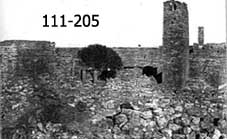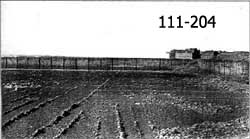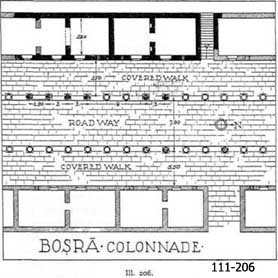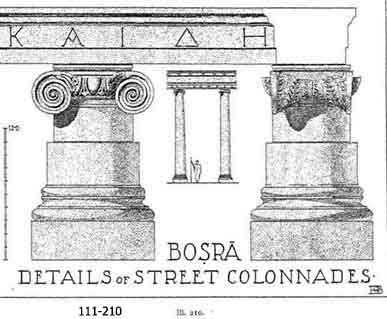|















|
|
Colonnaded Streets
|
Although the actual remains of colonnaded streets
in Bosra are scant and scattered, and are not to be compared, for
interest and perfection, with those of Palmyra or Gerasa, or even of
Philadelphia, a thorough examination of the ruins reveals the fact
that they were somewhat more extensive in this capital of the
Province of Arabia than in any of the cities above mentioned. The
colonnades of these three cities, and those of several other cities
of the Decapolis, seem to have been confined, for the most part, to
the two long streets, or avenues, which bisected the towns in
opposite directions, like the Via Principalis and the Via Praetoria
of a Roman camp, or, as in most cases, to the single main street
which ran through the longitudinal axis of the city. The colonnades
of Bosra, on the other hand, so far as we have been able to discover
from the remains, were not so long as the famous ones of Palmyra,
and were not even carried all the way through the city from wall to
wall; but were employed to embellish a greater number of parallel
streets and cross streets in the central part of the town.
On entering the principal West Gate of the city one finds remains of
the colonnades of what was the longest of the main avenues,
extending: in a direct line, a little to the south of east, through
groups of important buildings, to the East Arch which is not one of
the city gates corresponding to the West Gate, but a free standing
monument placed over the street at a point not more than three
quarters of the distance from the West Gate to the east wall of the
city, and marking, most probably, the entrance to the peribolos of a
great temple which stood in the highest-part of the city, well
within the east wall. Fragments of columns are to be seen all along
the route of this street; but no remnants of colonnades that are
definitely in place are encountered- until the centre of the city is
reached. Here, about 40 m. to the westward of the Central Arch (see
Map of Bosra), on the north side of the street, are four columns,
without capitals, built into a modern house the court-yard of which,
over a metre below the present surface of the soil about it, has for
pavement the ancient squared paving blocks of the Roman street.
Directly opposite, on the south side of the street which was a
little over 8 metres wide, are the bases of two columns still in
situ. These are in a direct line with an engaged column attached to
the west end of the Central Arch. The bases of four columns of the
colonnade are to be seen directly west of this arch which was set on
the line of the colonnade on the south side of the street. The
northern side of this colonnade appears again in drums of columns on
level beds, evenly spaced and quite certainly in situ, which emerge
from a dung hill directly west of the tetrastyle building marked
Nymphaeum on the map, and a bracket on the west face of the
westernmost of the four great columns of that building indicates
where the street colonnade was joined to the columns of the larger
order. At this point a break occurred in the north colonnade to give
space for two large buildings - the Nymphaeum and the Kalybe - and
for the passage of another colonnaded street which leads to the
north , between the two buildings . |
|

111. 205. Bosr
: Houses, Columns of Street, and Minaret of Djami1"
il-Khidr. View from Southwest, |
|
|

III. 204. Bosra: Southeast
Reservoir, View from the South East.
|
|
That The colonnades were continued farther to the
east is proved by a bracket attached to the east wall of the Kalybe,
and by the presence of three broken columns, now incorporated with a
house, on the north side of the street a little farther on. The
present narrow streets of the village of Bosra do not coincide with
the line of the ancient streets, the paving of which is to be found
in the basements or cellars of several modern houses that were
erected between the two rows of columns which flanked the street. No
signs of this chief east-and-west avenue were discovered east of the
East Arch.
A second east-and-west colonnade is to be traced in several groups
of columns on a line between the Djami' Fâtmeh and the Djami
il-Khidr. All these groups belong to the north side of the street:
first a pair and then a group of four columns without capitals
standing at a distance of 5 metres from a wall composed of shop
fronts which stood just west of the juncture of this street with one
running north and south: In the same line, about 50 metres to the
east, are two more pairs of columns built into modern walls ; of the
first pair, one column still preserves its capital, the shaft of the
other is complete. The other pair are headless, and stand, 5.70
metres apart on centres, farther toward the east.
A third east-and-west colonnaded street is represented by two groups
of columns, two and three, on opposite sides of a street 8.50 m.
wide on centres, 100 metres to the west of the line of the north
wall of the Djami' il-cOmari.
The principal north-and-south colonnaded street led from the main
North Gate southward, crossing two of the east-and-west colonnaded
streets at right angles, and meeting the main east-and-west street
at uneven angles masked by the presence of two large buildings
mentioned above, at the corners. The remains of colonnades along the
line of this street consist of two columns standing at about half
their original height, 8.80 m. apart on centres, on opposite sides
of the street, a short distance within the North Gate, and a row of
stumps, five in all, which are in place in front of a line of
shop-fronts just south of the juncture of the street with the second
east-and-west street, upon which, not far away, was the other row of
shops. Near these columns are well preserved sections of street
pavement. serving as a paving for the court-yards of modern houses
now well below the surrounding levels. The row of columns on the
west side of this street extended southward along the east wall of
the Market, and 5 m. from it, to the Nymphaeum which, as we have
seen, stands at the meeting place of these two principal streets.
The other north-and-south street with colonnades is marked by a row
of six columns to the northwest of the Djami' il-Khidr, spaced in
two groups, one of four and one of two columns, on a direct line
between the ancient spring and the principal east-and-west street:
two of these columns are perfectly preserved with a block of
architrave connecting them (111. 205), two others have their bases
exposed above a piece of ancient pavement. This row belonged to the
colonnade on the west side of the street, and stood in front of a
wall with doorways and windows in it which is the front wall of a
row of buildings (111. 206) which appear to have been houses rather
than shops. The width of the walk between the columns and the wall
is again 5.50 m., as in the case of the shop-front on the second
east-and-west street. Several column bases in a row 7.90 m. to the
east of the standing columns show that the street was in all
respects like the others.
It is probable, from the existence of engaged columns shown on the
south side colonnades were continued farther to the east is proved
by a bracket attached to the east wall of the Kalybe, and by the
presence of three broken columns, now incorporated with a house, on
the north side of the street a little farther on. The present narrow
streets of the village of Bosra do not coincide with the line of the
ancient streets, the paving of which is to be found in the basements
or cellars of several modern houses that were erected between the
two rows of columns which flanked the street. No signs of this chief
east-and-west avenue were discovered east of the East Arch.
A second east-and-west colonnade is to be traced in several groups
of columns on a line between the Djami' Fâtmeh and the Djami
il-Khidr. All these groups belong to the north side of the street:
first a pair and then a group of four columns without capitals
standing at a distance of 5 metres from a wall composed of shop
fronts which stood just west of the juncture of this street with one
running north and south: In the same line, about 50 metres to the
east, are two more pairs of columns built into modern walls ; of the
first pair, one column still preserves its capital, the shaft of the
other is complete. The other pair are headless, and stand, 5.70
metres apart on centres, farther toward the east.
A third east-and-west colonnaded street is represented by two groups
of columns, two and three, on opposite sides of a street 8.50 m.
wide on centres, 100 metres to the west of the line of the north
wall of the Djami' il-cOmari.
The principal north-and-south colonnaded street led from the main
North Gate southward, crossing two of the east-and-west colonnaded
streets at right angles, and meeting the main east-and-west street
at uneven angles masked by the presence of two large buildings
mentioned above, at the corners. The remains of colonnades along the
line of this street consist of two columns standing at about half
their original height, 8.80 m. apart on centres, on opposite sides
of the street, a short distance within the North Gate, and a row of
stumps, five in all, which are in place in front of a line of
shop-fronts just south of the juncture of the street with the second
east-and-west street, upon which, not far away, was the other row of
shops. Near these columns are well preserved sections of street
pavement. serving as a paving for the court-yards of modern houses
now well below the surrounding levels. The row of columns on the
west side of this street extended southward along the east wall of
the Market, and 5 m. from it, to the Nymphaeum which, as we have
seen, stands at the meeting place of these two principal streets.
The other north-and-south street with colonnades is marked by a row
of six columns to the northwest of the Djami' il-Khidr, spaced in
two groups, one of four and one of two columns, on a direct line
between the ancient spring and the principal east-and-west street:
two of these columns are perfectly preserved with a block of
architrave connecting them (111. 205), two others have their bases
exposed above a piece of ancient pavement. This row belonged to the
colonnade on the west side of the street, and stood in front of a
wall with doorways and windows in it which is the front wall of a
row of buildings (111. 206) which appear to have been houses rather
than shops. The width of the walk between the columns and the wall
is again 5.50 m., as in the case of the shop-front on the second
east-and-west street. Several column bases in a row 7.90 m. to the
east of the standing columns show that the street was in all
respects like the others.
It is probable, from the existence of engaged columns shown on the
south side of the Central Arch in old pictures of that building,
that a short colonnaded street extended from the arch to the west
end of the Theatre. It will be noted, by reference to the map, that
the two north-and-south streets are very nearly parallel to each
other, |
|
and that the two shorter east-and-west
streets run on parellel lines, at right angles to the other
two colonnaded streets ; but that the line of the principal
east-and-west street is not parallel to the other two streets
that lie in the same general direction, and is at right angles
only to the short street that is believed to have led off from
it in the direction of the Theatre.There is little room for
doubt that there were other colonnaded streets in other parts
of the city; for fallen columns and detached capitals and
bases, not in situ, are to be found in the large areas on the
north and south of the Naumachia, and on both sides of the
Theatre. But in the mediaeval period of the city's history,
when the castle and the greater of the mosques were built,
columns were much in demand for building stones. They were
used as so many blocks of ashlar if they had. been origin-ally
built up in sections, and were employed as bonding stones if
they had been set up as monoliths. For this reason few of the
columns of any of the colonnades are now found in situation;
they were easily removed, not being structurally connected
with the buildings, and they were transported with facility
owing to their position beside the public streets. |

|
|
|
It is very fortunate that any of these
columns escaped the despoilers of the colonnades, and I believe that
not one of them would have been preserved in its original place if
the small number cited above had not been incorporated, as they
stood, in the rough walls of buildings constructed before the
wholesale plundering of the colonnades had begun.
The few measurements already given would seem to show a very general
uniformity of plan in these colonnades. The two rows of columns of
the main avenues stood 8.80 m. apart on centres, giving a street 20
Roman cubits wide. The covered side walks between the columns and
the front walls of buildings were 5.50 m. wide on centres, leaving a
free space of 10 cubits width for the passage. It is particularly
interesting that we have found here the actual front walls of
buildings which lined the colonnades still in place. This feature,
which is wholly lacking in the other, and better preserved,
colonnaded streets of ancient Syrian cities, could be made an
important and beautiful historical monument if one might be
permitted to tear down and remove a number of poorly constructed
houses which occupy the side-walk space at several points along the
ancient street, utilizing the shop fronts, or house fronts, for one
wall, and filling up the spaces between the columns for another, and
making the ancient pavement serve for a floor. There may be other
and better examples of these buildings, which are the forerunners of
later Oriental bazaars and of the arcades of modern European cities,
in houses in Bosra which I did not enter, but the best that I saw is
represented by that long wall of shop-fronts with columns in front
of it (111. 207) which s shown on the map just west of the juncture
of the main north-and-south avenue with the second east-and-west
street, and now lies hidden in a maze of poor modern constructions.
|
|
The wall, well built in highly
finished ashlar of the Roman period, is intact in its lower
story for a distance of 28 m. from the street corner, and
preserves six doorways. There is a break of 12 m. and, beyond
this, the wall is continued with two doorways in place. The
rear wall and the partition walls of the shops were not to be
traced among the later walls of more recent buildings; for the
old and the new have been alike covered with mud; ut the long
front wall shows a broad pilaster at the angle, and, next to
it, a wide doorway, higher than the others, with moulded jambs
and decorated lintel, carved frieze, |

|
|
|
bdeep cornice, and low relieving arch (111.
208). Beyond this doorway is a row of doorways, almost equally
spaced, with moulded jambs and lintels, like the large doorway, but
having, in place of the frieze, cornice and relieving arch, an
overlintel of two pieces and a key-stone, like a flat arch. Enough
of the upper storey of this wall is preserved to show that there was
a large window above each doorway, and brackets above the lintel
line of the windows to receive the ends of the cross beams of the
roof of the colonnade. The columns with their entablature rose to
the level of the ceiling of the upper storey so that the doorways of
the lower storey and the windows of the upper storey were alike
protected by the roof over the side-walk. It is probable that the
wall was somewhat higher than the cornice of the colonnade to
receive the slanting rafters of the colonnade, and I have shown in
111. 207 a parapet at the top of the walls, which would be required
to weight the stone slabs of the roof of the shops themselves; for
it is most probable that both the lower and the upper storeys of the
shops were provided with stone ceilings carried on girder arches
according to the system usually practiced in Southern Syria. Another
colonnade which preserves both wall and columns intact is situated
in a part of the town more remote from the centre, northwest of the
Djamic il-Khidr. Here all the details are in a more perfect state of
preservation; but the building is less monumental and on a slightly
smaller scale (111. 209). Several columns are standing, two having
an architrave above them. The pavement of the street and of the
side-walk is visible at a number of points, and the building behind
the colonnade preserves not only its front wall, but its rear and
partition walls, as I have shown on the plan (111. 206). The upper
storey however has been partly rebuilt in comparatively recent
times, and a wall of crude workmanship has been erected between some
of the columns extending up to their full height, so that the
photograph given herewith (111. 209) is far less illuminating than
it might be. It shows, at the extreme right, a column standing to
about two thirds of its original height; then two columns carrying
an architrave, and, beyond this, the late wall referred to above
which, having been built in the line of the colonnade, conceals the
rest of the standing columns which have been incorporated with it.
The middle of the picture shows two storeys of a partition wall, the
lower having a large arch in it, the upper a doorway that has been,
filled up with stones. At the extreme left is the rear wall of the
house. The plan, already given in 111. 206, shows the same general
arrangement as that of the colonnade of the shops (111. 207): but
illustrates more fully the form and size of the chambers which open
upon the colonnade. Some of the chambers are connected with each
other by means of arches, many of them have windows, as well as
doorways, in the lower storey, and the fronts, though built of
highly finished stone work, are without ornament. These buildings
appear to have been residences, and, if this be true, it is
interesting to find that certain residential streets in Bosra were
provided with colonnades as well as the streets which were of a more
public character.
|

111. 209. Bosra: Columns of Colonnaded Street and Ancient
Houses. View from the Southwest. |

111. 208. Bosra: Doorway at End of a Row of
Shop-fronts.
|
| The architectural details of the
colonnades are to be studied in many parts of the city where
the columns have fallen; but at only two or three points where
they are still in place. The order is uniformly the Ionic in
Roman form with unfluted shafts (111. 210). There is a slight
difference in scale between the columns of the principal
streets and those of the side streets, the former having a
diameter of 80 cm. at the base, the latter of about 70 cm, The
bases are all of a well-drawn Attic type, the |
|
 |
|
shafts plain, but with diminution and
entasis, a slight apophyge at the bottom and a simple
fillet at the top. One capital is in place in the
colonnade of the second east-and-west street, eastward
from the shops, at a point where the present street
coincides with the ancient, and several of the columns
have been incorporated with modern walls. Two other
capitals still stand upon their shafts in the colonnade
already shown in 111. 209, and many which are no longer
in situ may be seen in the Djami il-cOmari. The only
architrave still in place is that carried by the columns
in front of the houses, shown in 111. 209; its profile
is given in the drawing of details. Near by on the
ground lie other pieces of the same architrave with
widely spaced letters which were parts of a long
inscription. The fragment which is still in place helps
us to identify other bits of architrave as having
belonged to the street colonnades; the most important,
perhaps, being those inscribed pieces which are to be
seen in such numbers built into the late front wall of
Dęr Bohęra. Neither frieze nor cornice was found in situ
at any place; but there are many pieces of both which,
from their scale, may be assumed to have belonged to
this order.
|
|
|
|
